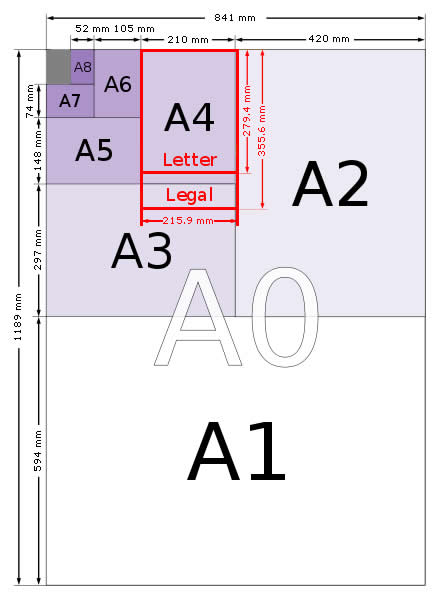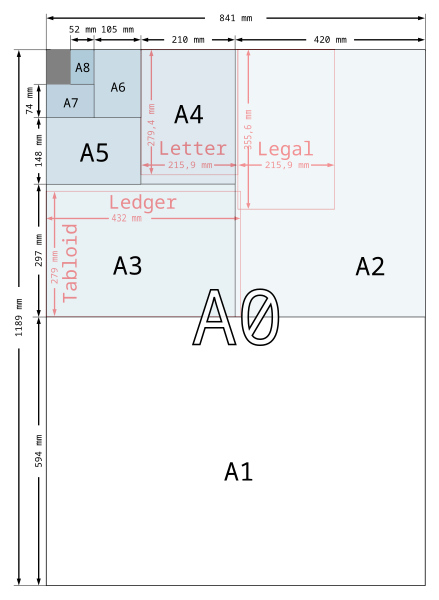| Size | Height x Width (mm) | Height x Width (in) |
| 4A0 | 2378 x 1682 mm | 93.6 x 66.2 in |
| 2A0 | 1682 x 1189 mm | 66.2 x 46.8 in |
| A0 | 1189 x 841 mm | 46.8 x 33.1 in |
| A1 | 841 x 594 mm | 33.1 x 23.4 in |
| A2 | 594 x 420 mm | 23.4 x 16.5 in |
| A3 | 420 x 297 mm | 16.5 x 11.7 in |
| A4 | 297 x 210 mm | 11.7 x 8.3 in |
| A5 | 210 x 148 mm | 8.3 x 5.8 in |
| A6 | 148 x 105 mm | 5.8 x 4.1 in |
| A7 | 105 x 74 mm | 4.1 x. 2.9 in |
| A8 | 74 x 52 mm | 2.9 x 2.0 in |
| A9 | 52 x 37 mm | 2.0 x 1.5 in |
| A10 | 37 x 26 mm | 1.5 x 1.0 in |
International Usage
The A series paper sizes are now in common use throughout the world apart from in the US, Canada and parts of Mexico. The A4 size has become the standard business letter size in English speaking countries such as Australia, New Zealand and the UK, that used to use British Imperial sizes. In Europe the A paper sizes were adopted as the formal standard in the mid 20th century and from there they spread across the globe.
http://www.papersizes.org/a-paper-sizes.htm
A series
The international paper size standard, ISO 216, is based on the German DIN 476 standard for paper sizes. ISO paper sizes are all based on a single aspect ratio ofsquare root of 2, or approximately 1:1.4142. The base A0 size of paper is defined to have an area of 1 m2. With this definition and the given aspect ratio of square root of two, one can calculate the sides of an A0 sheet as follows: The long side is 1 metre multiplied by the square root of the square root (that is, the fourth root) of 2 and the short side is 1 metre divided by the same. Rounded to millimetres, the A0 paper size is 841 by 1,189 millimetres (33.1 in × 46.8 in).
B series
In addition to the A series, there is a less common B series. The area of B series sheets is the geometric mean of successive A series sheets. So, B1 is between A0 and A1 in size, with an area of 0.707 m2 ( m2). As a result, B0 is 1 metre wide, and other sizes in the B series are a half, a quarter or further fractions of a metre wide. While less common in office use, it is used for a variety of special situations. Many posters use B-series paper or a close approximation, such as 50 cm × 70 cm; B5 is a relatively common choice for books. The B series is also used for envelopes and passports. The B-series is widely used in the printing industry to describe both paper sizes and printing press sizes, including digital presses. B3 paper is used to print two US letter or A4 pages side by side using imposition; four pages would be printed on B2, eight on B1, etc.
m2). As a result, B0 is 1 metre wide, and other sizes in the B series are a half, a quarter or further fractions of a metre wide. While less common in office use, it is used for a variety of special situations. Many posters use B-series paper or a close approximation, such as 50 cm × 70 cm; B5 is a relatively common choice for books. The B series is also used for envelopes and passports. The B-series is widely used in the printing industry to describe both paper sizes and printing press sizes, including digital presses. B3 paper is used to print two US letter or A4 pages side by side using imposition; four pages would be printed on B2, eight on B1, etc.
 m2). As a result, B0 is 1 metre wide, and other sizes in the B series are a half, a quarter or further fractions of a metre wide. While less common in office use, it is used for a variety of special situations. Many posters use B-series paper or a close approximation, such as 50 cm × 70 cm; B5 is a relatively common choice for books. The B series is also used for envelopes and passports. The B-series is widely used in the printing industry to describe both paper sizes and printing press sizes, including digital presses. B3 paper is used to print two US letter or A4 pages side by side using imposition; four pages would be printed on B2, eight on B1, etc.
m2). As a result, B0 is 1 metre wide, and other sizes in the B series are a half, a quarter or further fractions of a metre wide. While less common in office use, it is used for a variety of special situations. Many posters use B-series paper or a close approximation, such as 50 cm × 70 cm; B5 is a relatively common choice for books. The B series is also used for envelopes and passports. The B-series is widely used in the printing industry to describe both paper sizes and printing press sizes, including digital presses. B3 paper is used to print two US letter or A4 pages side by side using imposition; four pages would be printed on B2, eight on B1, etc.[edit]C series
The C series is used only for envelopes and is defined in ISO 269. The area of C series sheets is the geometric mean of the areas of the A and B series sheets of the same number; for instance, the area of a C4 sheet is the geometric mean of the areas of an A4 sheet and a B4 sheet. This means that C4 is slightly larger than A4, and B4 slightly larger than C4. The practical usage of this is that a letter written on A4 paper fits inside a C4 envelope, and a C4 envelope fits inside a B4 envelope.
http://en.wikipedia.org/wiki/Paper_size
Broadsheet Size
Dimensions: 750 x 600 mm (29.5" x 23.5")
Background
The term broadsheet derives from single sheets of political satire and ballads sold on the streets, which became popular after the British placed a tax on newspapers by the number of pages in 1712.
The broadsheet size for newspapers is becoming less popular and many titles are switching from broadsheet to tabloid.
In Australia and New Zealand the term broadsheet is used to refer to papers that are printed on A1 size paper (841 x 594 mm - 33.1" x 23.4").
Tabloid Size
Dimensions: 430 x 280 mm (16.9" x 11.0")
The tabloid size is often referred to as being 'half the size of a broadsheet' however this is not strictly true as broadsheet is 750 x 600 mm (29.5" x 23.5")
Tabloid size is actually not very different from A3 and thus a transition to printing tabloids on an A2 sheet (remember that newspaper sizes are the size of the folded pages) would be sensible in the longer term.
Background
The word tabloid when referring to newspaper sizes comes from the style of journalism known as 'tabloid journalism' that compacted stories into short, easy to read and often exaggerated forms. Tabloid journalism itself got its name from the 'tabloid pills' marketed in the 1880's, that were the first highly compacted and easy to swallow pills commonly available.
The tabloid size is widely used across the globe these days, with titles in the US, Russia, China, the UK, Canada, Australia, Brazil and many other countries using this format. Recently many established papers have changed from broadsheet size to tabloid size as it has proved more popular with readers.
http://www.papersizes.org/newspaper-sizes.htm
Traditional Paper Sizes
These traditional paper sizes are mostly of British origin. They are quite obsolete in Britain today, replaced by the modern ISO paper sizes. Some of them are still used, at least informally, in the U.S.
| Dimensions (inches) | |
| Executive | 7.25 x 10.5 |
| Quarto | 8 x 10 |
| Letter | 8.5 x 11 |
| Legal | 8.5 x 14 |
| Ledger (Tabloid) | 11 x 17 |
| Foolscap | 13.5 x 17 |
| Foolscap, oblong double | 13.5 x 34 |
| Pinched post | 14.5 x 18.5 |
| Crown (Post) | 15 x 20 |
| Post | 15.25 x 19 |
| Large post | 16.5 x 21 |
| Foolscap, double | 17 x 27 |
| Demy | 17.5 x 22.5 |
| Medium | 18 x 23 |
| Post, double | 19 x 30.5 |
| Royal | 20 x 25 |
| Crown, double | 20 x 30 |
| Large post, double | 21 x 33 |
| Imperial | 22 x 30 |
| Demy, double | 22.5 x 35 |
| Elephant | 23 x 28 |
| Medium, double | 23 x 36 |
| Royal, double | 25 x 40 |
| Atlas | 26 x 34 |
| Foolscap, quad | 27 x 34 |
| Crown, quad | 30 x 40 |
| Imperial, double | 30 x 44 |
| Demy, quad | 35 x 45 |
| Medium, quad | 36 x 46 |
| Crown, double quad | 40 x 60 |
http://www.unc.edu/~rowlett/units/scales/UKpapersize.html





No comments:
Post a Comment